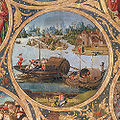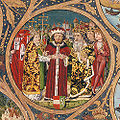Babenberger family tree
The Babenberger family tree is a panel painting from the workshop of the painter Hans Part , which was created between 1489 and 1492. The monumental (approx. Eight meters wide and four meters high) triptych is kept in the museum of the Klosterneuburg monastery and depicts all male representatives of the Babenberg family as well as the corresponding wives and some daughters. In addition to its considerable size, it also counts for medieval family trees unusual embedding of the depicted persons in scenic contexts as well as the high proportion of landscape painting to the remarkable works of late medieval panel painting in Austria.
History of origin
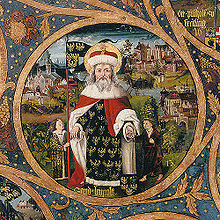

The occasion for the creation of the table work was the canonization of the Babenberger Leopold III. († 1136) , which took place on January 6, 1485. This marked the end of a lengthy process that had already begun in 1358 and led to an accumulation of source material about the life and veneration of the "mild" Margrave of Austria. Although the cult around Leopold III. had already started shortly after his death, as expected, after the canonization it gained increasing importance and popularity, as a result of which the streams of pilgrims to the tomb of the saint in the chapter house of Klosterneuburg Abbey intensified. In order to bring all these pilgrims closer to the new saint, his life and his origins, the provost of the monastery, Jakob Paperl (1485–1509), decided to commission a family history of the Babenbergs, which are also clearly presented in a monumental table should. The latter should make the mostly illiterate pilgrims as vividly and memorable as possible the family, which died out in 1246 and from which the new saint came.
It began in 1485 when Ladislaus Sunthaym was commissioned to work out a corresponding manuscript on the history of the Babenbergs, which for the Middle Ages reveals a surprisingly critical examination of numerous archives and sources and which finally went to press in Basel in 1491. This research formed the written basis for the three-winged panels that were created between 1489 and 1492. In the archives of the monastery, Hans Part is named as a painter, although it can be assumed that he ran a workshop in which several artists whose name was unknown were involved, as the work shows some stylistic inconsistencies.
The triptych was originally set up in the cloister of Klosterneuburg Abbey, very close to the burial place of St. Leopold. It probably did not form an altar, but was simply set up above the floor - which had a negative effect on the state of preservation, as the lower parts were affected by moisture. As a result, restorations often had to be carried out later, so that the original appearance can only be guessed at. The family tree, originally painted on wood, was transferred to canvas in 1843 and then set up in various locations in Klosterneuburg Monastery (including the monastery library and treasury). A restoration by Josef Schönbrunner from 1861, when the lower area was generously painted over, was particularly influential for today's appearance . A thorough restoration, carried out according to modern standards, did not take place until 1951–1965. It was found that from the original late Gothic stock, especially in the lower parts of the family tree, hardly any original substance has been preserved, which is why Schönbrunner's additions were left there.
Image content of the middle panel
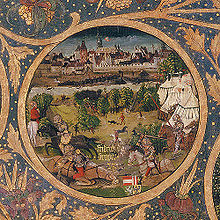
On the central panel of the triptych, all 27 male representatives of the Babenberg family are depicted in round medallions. The list begins in the lower area in the middle with Leopold I the Serene and ends with Friedrich II the arguable in the upper right corner. It is noteworthy that the male representatives are not shown here - as is usually the case with medieval family trees - simply in half-length pictures with their coats of arms, but embedded in an important scene in their lives. Hunts, ship journeys and funeral trains are shown, as well as momentous battles, sieges and murders.
The major role played by the landscape is another innovation compared to traditional medieval panel painting - in some medallions it even seems to play the main role. Above all, however, the city views make up the great charm of this work of art, as one can recognize in it a product of an exciting transition period between the Middle Ages and early modern times: Topographically precise views are mixed with freely varied or entirely invented city views without hesitation. For example, while the view of Vienna in the medallion of Frederick II can be considered reliable, the view of Klosterneuburg in the medallion of Leopold the Child was only extremely vague and the view of a port city in the medallion of Frederick I the Christian was entirely fictitious.
The 27 medallions represent the following Babenbergs and scenes:
- Leopold I the Serene : In the foreground in the fight against the Hungarians. In the background in front of Melk Abbey at the introduction of the first canons.
- Heinrich I the Unruly : In the background on the left Stockerau and on the right the martyrdom of St. Koloman .
- Archbishop Poppo von Trier : In the background of Trier .
- Ernst the Elder from Swabia : When hunting.
- Ernst the Younger of Swabia : murder of Ernst and Count Werner von Thurgau. In the background Falkenstein Castle in the Black Forest .
- Hermann IV of Swabia : funeral procession across the Alps accompanied by Emperor Konrad II and Empress Gisela .
- Adalbert the Victorious : Fight against the Hungarians. In the background Melk Abbey with the delivery of the cross relic.
- Leopold the Strong : In the army camp against the Hungarians.
- Seriousness of severity : Battle of the Unstrut. In the background in front of Melk Abbey with a Mauritius lance and Ulrich cup.
- Leopold II the Handsome : Battle of Mailberg . In the background in front of Melk Abbey with the introduction of the Benedictines and Gars am Kamp Castle.
- Albrecht the Frivolous: Invented Personality. Enfeoffment of his older brother with the Austrian mark. In the background Pernegg Castle .
- Archbishop Poppo von Trier: Invented personality. The Kuenringer Azzo is sent to Austria. In the background Trier.
- Leopold III. the saint : With two sons who died young. In the background the monasteries Klosterneuburg , Heiligenkreuz and Klein-Mariazell .
- Adalbert the Devout : Battle against the Hungarian usurper Borics.
- Leopold IV the Mild : Siege of Regensburg .
- Otto, bishop of Freising : In the background Freising .
- Conrad, Archbishop of Salzburg : In the background Salzburg .
- Ernst the young man : When hunting.
- Heinrich II. Jasomirgott : Seafaring to the Holy Land. In the background the Vienna Schottenkirche .
- Leopold V. the virtuous : Receipt of the red-white-red flag by Emperor Heinrich VI.
- Heinrich the Elder of Mödling : Fights in Moravia. Mödling Castle in the background.
- Heinrich the Younger von Mödling : When hunting. On the right oldest representation of Laxenburg Castle .
- Frederick I the Christian : Journey to the Holy Land. In the foreground the return of the Duke's body.
- Leopold VI. the honorable : peace treaty of San Germano. In the background Lilienfeld Abbey and Wiener Neustadt .
- Leopold the child : Runs away from his teachers. Klosterneuburg in the background.
- Heinrich the Cruel : Conquest of Hainburg . Left: his mother Theodora escapes.
- Friedrich II. The arguable : Battle of the Leitha . Vienna in the background.
In the lower right corner of the picture, the central panel is also enriched by the legend of the enfeoffment of the first Babenberger (Leopold I) with the Austrian mark. According to a variant of the legend, the depiction shows King Henry I , whose bow is said to have broken during a hunt. As a result, Leopold I is said to have given the king his own bow, which enabled him to kill the stag to be captured and enfeoffed Leopold I with Austria. Other versions of the legend report that the king's bow broke the moment a raging boar ran towards him. Only at the very last moment was the emperor able to kill the boar with the bow handed over by Leopold I and thus save his life.
Image content of the side wings
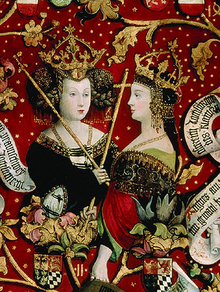
The two side wings show a total of 46 wives and daughters of the Babenbergers, whereby the representation of half-figures growing up from flower tendrils with corresponding coats of arms follows the more common tradition of medieval family trees. Overall, however, the orderly system of the central panel is missing in the side wings. In addition, it is assumed that other artists were involved in the execution of the side wings than in the central panel. Since the faces of women were particularly heavily reworked in the 19th century and the original appearance can therefore only be roughly guessed, no reliable stylistic attributions can be made. The side wings are also interesting in terms of costume history, as the Babenberg women are shown in clothes from the late 15th century.
The diverse origins of the women portrayed make it clear how far the Babenbergs ramified and how the nobility manifested itself through its marriage policy in the High Middle Ages . For the Babenbergs there were family connections not only with other ducal houses, but also with the kingdoms of Hungary and Bohemia, as well as the German and even Byzantine imperial family (e.g. Duchess Theodora , wife of Heinrich II. Jasomirgott, or Theodora Angela , wife of Leopold VI .). In the right wing, Agnes von Waiblingen is magnificently highlighted - the wife of Leopold III, for whose veneration the family tree was created. With an imaginatively designed, magnificent crown, she is clearly distinguished as the daughter of a German emperor and with a model of the Klosterneuburg collegiate church as a co-founder of the Klosterneuburg monastery. In the left wing, on the other hand, Gertrud von Babenberg is interesting, who was entitled to inheritance after the death of the last male Babenberger, Frederick II the Controversial, and was therefore often married for political reasons.
literature
- Floridus Röhrig: The Babenberg family tree in Klosterneuburg Abbey . Vienna 1975.
- Floridus Röhrig (Red.): Saint Leopold. Prince and state symbol . Catalog of the Lower Austrian state exhibition in Klosterneuburg Abbey. Niederösterreichisches Landesmuseum, Vienna 1985, ISBN 3-900464-22-7 , p. 297 f.
- Georg Scheibelreiter: The Babenberger family tree from Klosterneuburg. Backward-looking heraldry as a code of historical events , in: coat of arms and kinship network. Research on the history of culture and mentality on heraldry and genealogy . (= MIÖG; supplementary volume 53). Böhlau, Vienna 2009, ISBN 978-3-205-78319-0 , p. 177 ff.








